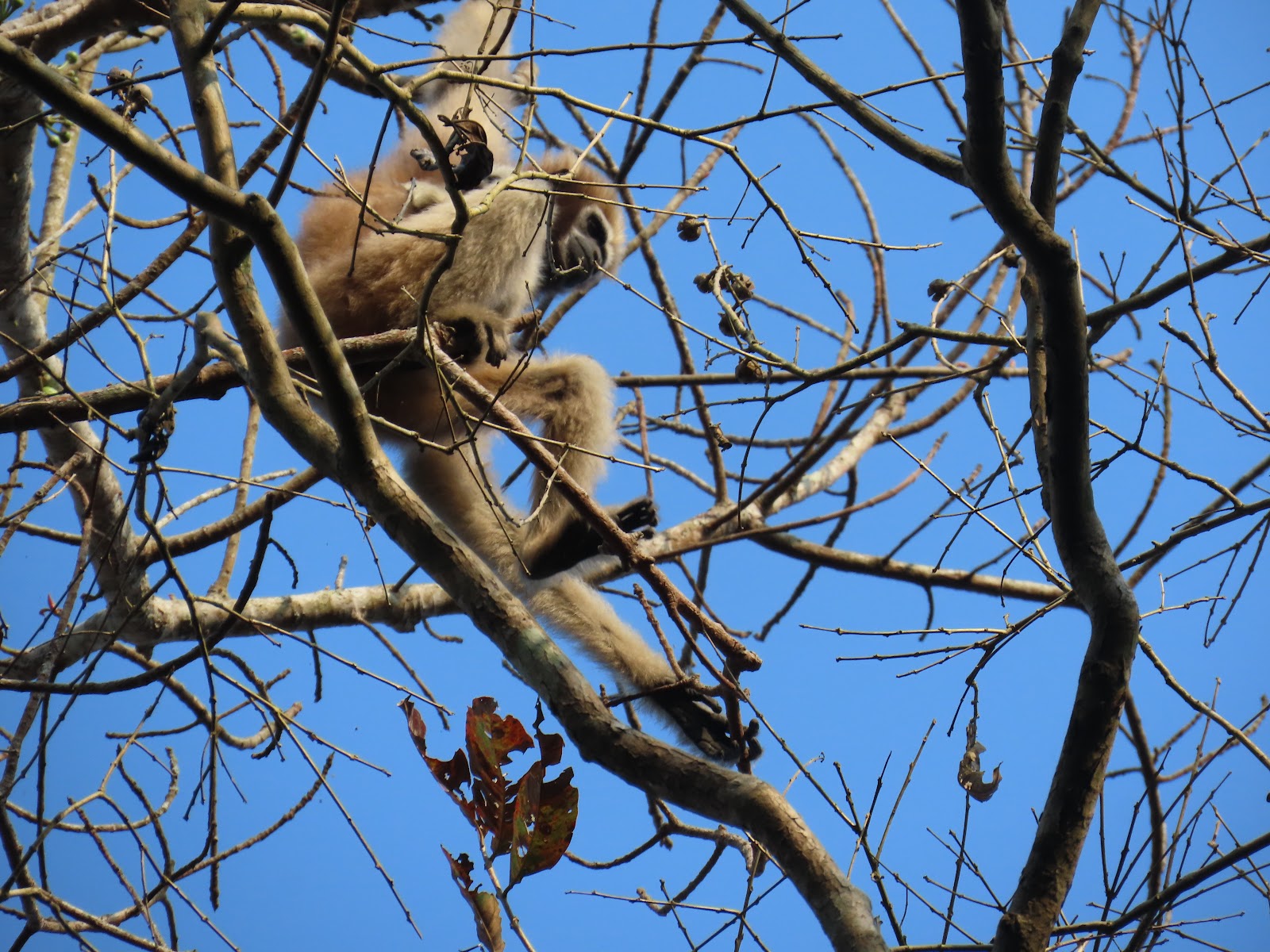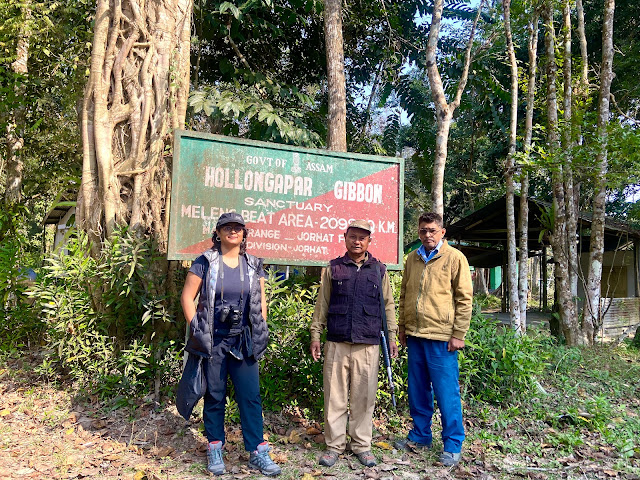 |
| A male hoolock gibbon at the Hollongapar Gibbon Sanctuary. Image credit: Oishimaya Sen Nag |
Our closest relatives on our Planet Earth, the Greater Apes, like the chimpanzees and gorillas of Equatorial Africa and the orangutans of Southeast Asia, are no strangers to us, thanks to many mentions of these animals in popular culture. We humans share well over 95% of our genetic code with these apes, who are heavily featured in films, documentaries, books, and social media worldwide. However, did you know that India is also home to an ape species closely linked to us on the evolutionary tree? It is the Western hoolock gibbon or Hoolock hoolock. Interestingly, the species is often reported as India's one and only ape, leaving out humans who, according to taxonomic classification, belong to the same family Hominidae as the Greater Apes and, hence, might also be regarded as an ape species. Coming back to the Western hoolock gibbon, however, it is important to know that they are no less fascinating than a chimpanzee or an orangutan but mostly remain out of the spotlight. Sadly, the apathy shown to them is a major reason why the numbers of these apes are dropping perilously. So, here is an article dedicated to the fascinating Western hoolock gibbons of India.
Where To Find The Hoolocks In India?
In taxonomic terms, the Western hoolock gibbon is a gibbon species of the Hylobatidae family, which accommodates four genera with 20 species. These lesser apes lack a tail like all other apes, distinguishing them from other primates like the monkeys. The genera Hoolock includes three species, of which only the Western hoolock gibbon inhabits India, as confirmed by a 2021 scientific study.
The Hollongapar Gibbon Sanctuary in Assam near the quaint Assamese town of Mariani is the best bet for those interested in watching these apes in action. It is a beautiful, lush wilderness dedicated to these gibbons, although it also houses six other primate species as well. Jorhat in Assam houses the nearest airport to this sanctuary.
 |
| Trail path through the Hollongapar Gibbon Sanctuary, Assam. The forest is an ideal example of a prime habitat of the Western hoolock gibbon. Image credit: Oishimaya Sen Nag |
The Western hoolock gibbon has also been reported living in other forests of the state and across the six other north-eastern states of the country, namely, Arunachal Pradesh, Mizoram, Manipur, Nagaland, Tripura, and Meghalaya. Its range also stretches into parts of Myanmar and Bangladesh. However, the species' distribution across the range is highly patchy due to the extremely fragmented nature of their habitat.
What is vital for these gibbons is the presence of a continuous cover of trees to support their nearly 100% arboreal lifestyle. These gibbons occupy canopies in tropical and sub-tropical evergreen and semi-evergreen forests with limited distribution in other types of forests like deciduous.
The Hoolock Look
Video: Male Western hoolock gibbon feeding on a tree. Video credit: Oishimaya Sen Nag
It appears that nature has taken great care in designing the Western hoolock gibbons. Males and females exhibit sexual dimorphism, with males sporting a black pelage while females adorn a brownish-grey fur that is darker at the chest and neck. Two white fur patches over the eyes of the males give them the name "white-browed" gibbons, while females have a mask-like appearance with whitish rings around the eyes and mouth. Juveniles of both sexes are born with a pale brownish fur that turns black as they grow. Upon maturity, the black in females changes to their adult colouration.
 |
| A female Western hoolock gibbon. Image credit: Oishimaya Sen Nag. |
Hoolocks are not just interesting in appearance. They are also well-adapted to living on the trees. Watching them moving from one tree to another at speeds of up to 55 km/hr by brachiation is quite a delight. Their long forelimbs, hook-like elongated fingers, prehensile feet and flexible ankle joints all come together to make them true tree-dwellers. They also exhibit suspensory feeding, where they dangle from a tree with one of their hands clinging onto a branch and eating with the other hand.
What Hoolocks Eat And Drink?
The Western hoolock gibbon is primarily a frugivore; it specialises in feeding on fruit pulp and has a simple stomach that cannot digest complex compounds. When food is scarce, these gibbons might resort to feeding on other plant parts like flowers, leaves, and shoots, or even insects or other animal matter as well. Hoolocks spend over 27% of their daily time foraging and more than 30% of their time feeding. The rest of their time goes into resting, socialising, and other activities. As they almost never come down to the ground, they get their water from the food they eat and also drink water collected in the tree hollows by scooping it up with their hands and licking it.
The Hoolock Family
Hoolock gibbons do not form very large social groups but exist in small family groups, each with an adult male and female and three to four of their offspring. Larger groups sometimes exist, especially when large patches of unfragmented habitat are present. While these gibbons are known to be monogamous, mating with the same partner throughout their lifetime, exceptions have also been observed.
Males usually initiate mating, approaching females, with the couple grooming, playing, and spending time together before copulation. A single offspring is born after a gestation period of 180 to 240 days.
Saving The Hoolocks
It is quite easy to understand why the Western hoolock gibbon is a threatened species occupying the "Endangered" position on the IUCN Red List. It absolutely needs continuous tree cover to survive, and that is what is totally lacking in the range occupied by this species.
Deforestation across the species' range to make space for human occupation, tea gardens, other agricultural practices, etc., has reduced the connectivity between forest patches occupied by these gibbons. The populations are now isolated across the range in islands of forests surrounded by multiple-use landscapes. Without a connection between populations, inbreeding is unavoidable, reducing the genetic vitality of the species. Further, even these forested habitats are further fragmented by linear infrastructure. For example, a 1.6 km railway line runs right through the Hollongapar Gibbon Sanctuary, fragmenting it into two unequal halves with hoolock gibbon populations on either side but disconnected from each other. In some parts of their range, these primates are also poached for meat and other body parts for use in traditional practices.
 |
| Railway line cutting through the Hollongapar Gibbon Sanctuary, separating hoolock gibbon families on either side of the railway line. Image credit: Oishimaya Sen Nag |
Saving the future of the Western hoolock gibbon won't be easy, given their highly specific needs for dense forest cover and the rapid urbanisation and developmental activities occurring across its range. However, conserving the species is vital to protect not just the gibbons but also the highly biodiverse forests they occupy, which provide humans with numerous ecosystem services that are absolutely needed for our healthy and peaceful living.
More focus on the Western hoolock gibbon is needed. It is a species that remains out of the spotlight. Many people across the country are not even aware of the presence of such a unique ape species, but many are often obsessed with chimpanzees and orangutans found in other countries. The Western hoolock gibbon is a source of pride for India and a valuable inhabitant of the country. We all need to play an essential role in creating education and awareness about the species and the need to conserve it.
Writer: Dr. Oishimaya Sen Nag


No comments:
Post a Comment